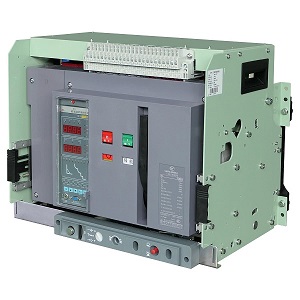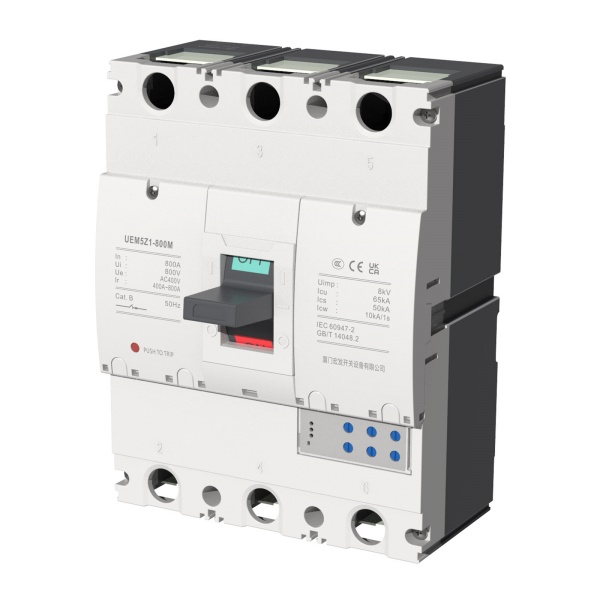In the power system, the circuit breaker is one of the important components to ensure the safe operation of the equipment. Correctly setting and using the circuit breaker can effectively prevent the losses caused by electrical faults. This article will discuss in detail the conditions for the circuit breaker to trip, the reasons for the over-tripping and its treatment methods, and summarize the relevant knowledge points. Through these analyses, we can better understand the role and importance of circuit breakers in the power system.

UEW5-3200 Universal Circuit Breaker
Part.1 The circuit breaker tripping needs to meet two conditions
1. The fault current reaches or exceeds the set action current value
2. The duration of the fault current reaches the set action time
Therefore, to ensure that the circuit breaker does not over-trip, it is necessary to coordinate the current setting value and the time setting value.
Assuming that the overcurrent protection setting value of the first-level circuit breaker is 700A and the duration setting value is 0.6 seconds, the overcurrent protection setting value of the second-level circuit breaker should be reduced according to a certain ratio, such as the current setting value is set to 630A and the time setting is 0.3 seconds. In this case, if a fault occurs within the protection of the second-level circuit breaker, regardless of whether the fault current reaches the set value of the first-level circuit breaker, the first-level circuit breaker will not trip because the fault current will be cut off by the second-level circuit breaker when it lasts for 0.3 seconds, and will not reach the 0.6 seconds of the first-level circuit breaker, thus avoiding over-tripping.
Part.2 Analysis of over-tripping situations
Situation 1. The load capacity of the main switch is less than the total capacity of the load of the sub-switch.
Situation 2. The main switch has a leakage protection device but the sub-switch does not. When the leakage of the electrical appliance is greater than or equal to 30 mA, the main switch trips.
Situation 3. The protection of the two-level circuit breakers does not match. Try to use circuit breakers of the same brand.
Situation 4. Frequent operation of the main switch with load leads to electric shock, carbonization, poor contact, increased resistance, increased current, and heating tripping.
Situation 5. The protection configured by the lower-level circuit breaker cannot correctly judge the fault (for example, a single-phase grounding fault but no zero-sequence protection is configured).
Case 6. The aging of the circuit breaker causes the shunt tripping time to become longer. A shunt tripping time of less than the upper switch should be replaced.
Part.3 Treatment method
People Marking If the upper circuit breaker trips across the level, if it is found that the branch protection is activated, but the branch circuit breaker has not tripped, then disconnect the circuit breaker at this level, and then restore the upper circuit breaker; if it is found that the branch protection has not acted, check whether there is any fault in the equipment within the power outage range. If there is no fault, close the upper circuit breaker and try to send each branch circuit breaker one by one. When the power circuit breaker trips again when sent to a certain branch, it can be determined that the circuit breaker is a faulty circuit breaker. The line can be isolated, repaired and replaced.
Part.4 Summary of knowledge points
1. In terms of protection type, whether it is a short circuit fault or a ground fault, the principle is the same, and it is acted by judging the current size and duration.
2. It should be said that the coordination in time is more important, because the fault current is likely to meet the protection setting size of multiple circuit breakers at the same time.
3. The protection setting of the circuit breaker is set, and the time is also set. Does this ensure that there is no overstepping? Not necessarily. Why? From the setting value, like the above example, it seems that it should be coordinated at a glance, but in reality, the time required for the circuit breaker to completely disconnect the fault current, in addition to the basic judgment time, must also be added to the mechanical action time. This time length varies depending on the performance of equipment from different manufacturers, but because the protection time of the circuit breaker is in milliseconds, this difference may also affect the coordination between circuit breakers.

UEM5Z1 Electronic MCCB Circuit Breaker
What does it mean? That is, like the above example, the second-level circuit breaker should have cut off the fault current in 0.3 seconds, leaving the first level without a chance to act, but the mechanical performance is too poor, and it takes 0.4 seconds to completely disconnect. Before the second level is completely disconnected, the first-level circuit breaker has detected that the fault current has lasted for 0.6 seconds, so the first level will also act, which leads to overstepping tripping. Therefore, to ensure that there is no over-tripping, the actual total length of the circuit breaker’s operating time must be tested with relay protection equipment, and the length of the actual test results must be used to ensure correct coordination.
Post time: 7 月-19-2024


